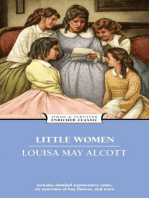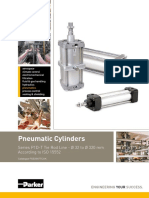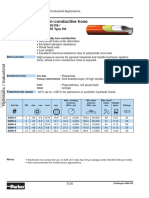Sundstrand
Sundstrand
Uploaded by
Zoran Jankov0 ratings0% found this document useful (0 votes)
155 views28 pagesOriginal Title
sundstrand
Copyright
© © All Rights Reserved
Available Formats
PDF or read online from Scribd
Share this document
Did you find this document useful?
Is this content inappropriate?
Report this DocumentCopyright:
© All Rights Reserved
Available Formats
Download as PDF or read online from Scribd
Download as pdf
0 ratings0% found this document useful (0 votes)
155 views28 pagesSundstrand
Sundstrand
Uploaded by
Zoran JankovCopyright:
© All Rights Reserved
Available Formats
Download as PDF or read online from Scribd
Download as pdf
You are on page 1of 28
Bulletin 9646
May 1974
15 SERIES
HYDROSTATIC
TRANSMISSIONS
Echos)
Sundstrand Hydro-Transmission
TABLE OF CONTENTS
Introduction
Section | Series Configuration and Specifications
Section |] System Circuit Description
Section II: Fluid Recommendations
Section IV: Start Up Procedures
Section V: System Maintenance
Section VI: Trouble Shooting Procedures
Section VII: Repair Procedures
INTRODUCTION
‘The purpose of this manual is to present the information necessary for normal servicing of the
Sundstrand 15 Series Hydrostatic Transmissions. This includes component function and description as
well as general trouble shooting and repair procedures.
Cleanliness \s the primary means of insuring satisfactory transmission life either on new or repaired units.
As with any precision equipment, the internal mechanism and related items must be kept free of
chemical and particulate contaminants.
SECTION I: SERIES CONFIGURATIONS AND SPECIFICATIONS
MoTOR
SPLIT SYSTEM
INLINE
SPECIFICATIONS
PUMP DISPLACEMENT:
PUMP INPUT SPEED:
MOTOR DISPLACEMENT:
MOTOR OUTPUT SPEED:
MAX. OPERATING PRESSURE
CHARGE PUMP DISP:
CHARGE RELIEF SETTING:
MAX. INLET VACUUM
MAX. CASE PRESSURE:
IMPLEMENT RELIEF SETTING:
FILTRATION:
0.913 in3/rev
Up to 4900 RPM
913 in Sfrev
0-400 RPM
3000 PS!
-19, 30 or 33 in?/rev
70-150 PS!
Bin. hg.
15 PSI
550-700 PSI or 700-800 PSI
25 Micron (nominal)
Relief valve pressures are set at 3600 RPM pump speeds
Consult specific unit description to determine which option is used for Charge Pump Disp.,
Implement Relief Valve Setting, Mounting Flange for Inlines and Shaft Configuration.
SECTION I
CONFIGURATIONS AND SPECIFICATIONS, SPLIT SYSTEM
DRAIN PORT (BOTH SIDES) GAUGE PORT
SYSTEM PRESSURE
GAUGE PORT
CHARGE PRESSURE
PORT A
‘OUTPUT SHAFT
IMPLEMENT
PORT B.
PORTS (2)
INPUT SHAFT
MOUNTING FLANGE
SAE TYPE A 2 BOLT
MOUNTING FLANGE
PORT A, PORT 8 & DRAIN PORT
FORTANPORT Biel CONTROL SHAFT SAE TYPE B 2 BOLT
INLET PORT
PUMP—VARIABLE
MOTOR—FIXED.
DISPLACEMENT. =|
DISPLACEMENT
ALL PORTS ARE SAE STRAIGHT THREAD O-RING TYPE EXCEPT GAUGE PORTS WHICH ARE
1/8 PIPE THREAD
DRAIN PORT. INLETPORT | _ IMPLEMENT PORT
PORTA PORT B.
3/4=16 9/1618
3/4=16 3/4=16 3/416
TRL fee
KS
PUMP MOTOR
SECTION I Es
CONFIGURATIONS AND SPECIFICATIONS, INLINE TYPE
OPTIONAL MOUNTING FLANGES:
SAE TPE A cents dato
SEEMING Gauce pont
SE errs une
IMPLEMENT PORTS (2)
9/16-18 SAE STR. THD.
O-RING TYPE GAUGE PORT
CHARGE PRESSURE
1/8 PIPE THD.
OUTPUT SHAFT
/
CONTROL SHAFT INPUT SHAFT
INLET PORT FILTER PAD.
3/4-16 SAE STR. THD.
O-RING TYPE
* CASE MUST DRAIN DIRECTLY INTO OUTPUT AXLE OR GEARBOX THROUGH SHAFT
DIMENSIONS SHOWN FOR SAE TYPE A 2 BOLT MOUNTING FLANGE.
INLINE,
SECTION I: CONFIGURATIONS AND SPECIFICATIONS, U TYPE
IMPLEMENT PORTS (2)
9/16-18 SAE STR. THO.
O-RING TYPE
GAUGE PORT
CHARGE PRESSURE,
1/8 PIPE THD, INPUT SHAFT.
PTO SHAFT.
S|
“ouput suaer
DRAIN PORT*
MOUNTING FLANGE
INLET PORT.
718-14 SAE STR. THO.
O-RING TYPE
* CASE MUST DRAIN DIRECTLY INTO OUTPUT AXLE OR GEARBOX THROUGH.
406 DIA. PORT.
ese case re
SECTION II: SYSTEM CIRCUIT DESCRIPTION
Pump/Motor
The 15 Series hydrostatic transmission consists of @
variable displacement axial piston pump connected
in @ closed loop to a fixed displacement axial
piston motor. The variable displacement pump is
driven by 2 prime mover (internal combustion
engine, electric motor, etc.) and the fixed motor,
which is driven by the fluid from the pump, drives
the machine (vehicle, hoist, conveyor, etc), The
direction of rotation and speed of the fixed motor
output shaft depends on the flow from the pump
and the system pressure is determined by the
machine load,
Charge Pump
The Axial piston pump and motor have a small
amount of internal leakage which is removed from
the Pump/Motor closed loop circuit. This results in
fluid loss from that circuit which must be
replenished to prevent cavitation. To accomplish
this task, a fixed displacement pump (gerotor type)
is used, It is driven directly by the prime mover
through the variable displacement pump shaft. This
Charge Pump provides a predetermined amount of
fluid that is used by the Pump/Motor circuit as
required to replenish leakage losses.
Since the Pump/Motor circuit is a closed loop, and
either side can be pressurized, two (2) directional
control check valves are needed to direct Charge
Pump flow into the low pressure side of the circuit.
‘The pressure in this Charge Pump circuit is limited
by a factory set, direct operating relief valve. Any
fluid not being used is discharged from the circuit
over this valve and passes through the pump and
motor housings and back to the system reservoir.
INPUT SHAFT ow
UtroeCTONAL ——_ BLBMEC TONAL
frame, we of wore
wand outrut suaer
sao SroIReCTONAL
ra
CHARGE RELIEF
CHARGE
PUMP
IcHARGE|
SECTION II: SYSTEM CIRCUIT DESCRIPTION
Control
The speed at which the output shaft turns is proportional to the position of the control lever (or
pedal) and is infinitely variable between zero and maximum speed. The direction of rotation of the
output shaft depends on the position of the control lever (pedal) in relation to the neutral position
(forward or reverse).
The variable displacement pump has 2 manual
control (lever or pedal) connected directly to
the tiltable swashplate so that as the operator
moves the control, the swashplate tilts to a
corresponding angle resulting in fluid flow from.
the pump. The fluid enters the fixed
displacement motor and pressure increases until
the motor (output) shaft begins to rotate.
When the swashplate (control lever} is at neutral
(zero tilt angle) there is no stroking of the
internal axial pistons and therefore, no flow
from the pump to the motor.
The direction of motor (output) shaft rotation
depends upon which port the fluid enters,
Reversing the direction that the swashplate is
tilted from neutral (zero angle) reverses the
output shaft rotation hence the direction of the
machine.
SECTION I
Optional Implement Relief Valve
In many applications it is desirable to operate
auxiliary equipment or implements with the excess
Charge Pump supply. In these cases a second relief
valve is added to the transmission circuit which
allows intermittent operation of the Charge Pump
at higher pressure (up to 800 PSI). The Implement
Circuit must be of the “Open Center” type so that
when not in operation the excess Charge Pump
low spills across the Charge Relief Valve, which is
set_at normal Charge pressure, through the
Implement Circuit and into the pump housing.
When the Implement Circuit is being operated the
charge pressure can build up to the higher setting
of the Implement Relief Vaive.
Optional Acceleration Valves (Not available on
“U" Configurations)
One of the characteristics of a closed loop system
is its instantaneous response to control input
signals, This characteristic may not be desirable in
some applications. Acceleration control valves can
be added to give a desirable machine response rate.
These valves consist of spring loaded spools that
by-pass some of the pump flow around the fixed
motor so maximum flow does not reach the motor
instantly even though a maximum command has
been given (control stroked rapidly). These valves
close at a predetermined rate as system pressure
increases giving a safe response rate.
: SYSTEM CIRCUIT DESCRIPTION
“OPEN CENTER’
IMPLEMENT CIRCUIT
IMPLEMENT CHARGE
ELIE VALVE J RELIEF VALVE
=
Pep)
BY-PAS
VALVE
(MANUAL)
ACCELERATION
SECTION Il: SYSTEM CIRCUIT DESCRIPTION
Optional By-Pass Valve
In some applications it is desirable to by-pass
fluid around the fixed displacement motor so
that a vehicle can be moved (pushed) short
distances without running the prime mover. For
all configurations except the “U" type, this
function is accomplished by adding screw in
type valve which when open (unscrewed)
connects both sides of the Pump/Motor circuit
and allows the fixed motor to free wheel. This
by-pass valve should be fully closed during
normal operation to obtain max. performance
and to prevent heat build up, In the “U"
configuration a manual button is incorporated
into the Charge Check Valves so that these
valves can be held open to free wheel the fixed
motor.
Inlet Filter
It is imperative to insure that only clean fluid
enter the hydrostatic transmission
circuit;therefore, a 25 micron (nominal rating)
filter is required in the Charge Pump inlet line.
This filter should not have a by-pass and must be
changed regularly to insure system reliability.
Reservoir
The reservoir is an important component of the
system, The suggested minimum reservoir total
volume (in gallons) is five-eights (5/8) of the
Charge Pump flow (in gallons per minute) with a
minimum fluid capacity equal to one-half (1/2)
the charge pump flow.
Example: Charge Pump flow equal to 2 GPM
Total Reservoir capacity equal to
1-1/4 gallons
Fluid Capacity equal to 1 gallon
The Charge Pump inlet port in the reservoir
must be above the bottom of the reservoir and
must always be covered with fluid.
The return port should be located as far from
the inlet port as possible to provide maximum,
dwell time of the fluid in the reservoir. The
returning fluid must always discharge below the
fluid level.
If an open or air breathing reservoir is used, the
air breather must be of sufficient capacity to
Prevent excessive contamination from airborne
particles.
Heat Exchanger
The hydrostatic transmission should not exceed
200°F as a continuous operating temperature,
To maintain this maximum temperature may
require the addition of a Heat Exchanger in the
line returning fluid to the reservoir, The
optimum Heat Exchanger should be capable of
dissipating at least 25% of the maximum input
horsepower to the transmission.
Example: Maximum Input Horsepower at
BHP
Heat Exchanger Capacity at 2 HP
SECTION Il: SYSTEM CIRCUIT DESCRIPTION
auanasomiv
sunssaua asv2 []
sunseaus wom
aunssaus souveo
mors wouons (ii)
uolssiWwsued|-o1pAH puesjspuns
ee monyasau
uoLow Anawaoviasio axis |
WvuDvia MOT4
oISva — YOLOW G3xI4
dWNd JIAVINWA S3IIN3S SL
wanna
\
“dung ANaWa2vIaSIO STEVINYA
ise. \ s i PROTON,
dE Arai.
|
2 AvaWassy. aS
Ny] S aay ‘sana xan wc NN
| Pe |
SECTION I
Hydraulic fluids selected for use with the
‘Sundstrand hydrostatic transmission should be a
quality product carefully selected with
assistance from a creditable supplier.
Characteristics of the fluid selected should
include:
Viscosity
Oxidation
Thermal Stability
Shear Stability
Low Temperature Fluidity
Rust Inhibition
Anti Foam
Water Compatibility
Filtration Limitations
Anti-Wear Properties
The following types of fluids have been used
FLUID RECOMMENDATIONS
transmission: (1) anti-wear hydraulic oil, (2)
automatic transmission fluid - Type “F”,
and_ (3) hydraulic transmission fluid (type used
by the Agricultural industry for combined
transmission, hydraulic and wet brake systems).
If a fire resistant fluid is required, Pydraul 312
has been satisfactory.
Most of the above fluid types have acceptable
viscosity characteristics in the operating range of
0° F. to 200°F. The fluids selected should
provide a minimum viscosity of 47 SUS at
210°F. end a maximum measured viscosity of
6000 SUS at the lowest expected startup
temperature. Typical fluid properties are listed
on the attached table,
Your best assurance for a quality product is the
assistance that can be offered in its selection by
a fluid supplier. The major oil companies are
successfully in the hydrostatic quite capable of providing suitable products.
Typical Viscosity r Pour | Operati
SUS Viscosity | Point "Range
Fluid Type oor 100°F =| 210°F | Index oF (Typical °F)
Anti-Wear
Hydraulic
oil 7,000 200 50 130 30 0-200° F.
Type “F"” 3,200 212 57.2 | 208 -40 -15-200° F.
Hydraulic
Transmission
Oil 12,000 233 49 100 38 0.200° F.
*Pydraul
312 100,000 312 51 7 “10 50-200° F.
* Fire Resistant Fluid
10
3
SECTION IV: START UP PROCEDURE
Prior to installing the transmission, inspect
for damage during shipment and handling,
Make certain all circuit components
(reservoir, hoses, fittings, heat exchanger,
etc) are clean prior to installing and filling
with flui
Fill the reservoir with recommended
hydraulic fluid which should be passed
‘through a 25 micron (nominal) filter prior
to entering the reservoir. Never reuse fluid,
The inlet line leading from the reservoir to
the pump housing on the transmission must
be filled prior to start up. If gravity feed
does not fill this line, it must be filled
manually. Remember that the maximum
inlet vacuum at normal conditions should
not exceed 5 in. hg. Check inlet line for
properly tightened fittings and be certain it
is free of restrictions.
Place the control lever in neutral. The
control linkage must be disconnected from
‘the transmission during initial start up.
Remove the plug from the charge pressure
port and slowly turn the input shaft (hand
cranking is recommended) until fluid flows
from this port.
Install a pressure gauge (1000 PSI) in the
charge pressure port with a short section of
hose and a snubber or needle valve to
10.
"1
dampen pulsations. Charge pressures should
read as follows after start up:
15 Series
15 Series with Implement Valve
550-700 PSI or 700-800 PSI
70-150 PSI
Start the prime mover and run at the
lowest possible RPM until normal charge
pressure has been established. If an
Implement Circuit is used cycle the
Implement Control Valve slowly to fill that
system,
Once the proper charge pressure has been
established increase the speed to full RPM.
If Charge Pressure is not maintained (it
may increase but not decrease), shut down
system and determine cause.
Run system at full input and output speeds
in both directions and observe Charge
Pressure.
Operate system for at least fifteen (15)
minutes then shut down and replace the
inlet filter. Remove gauge and plug port.
Check fluid level in reservoir.
Transmission is ready for operation.
W
SECTION V: SYSTEM MAINTENANCE
The hydrostatic transmission and related system
components, no matter how perfectly matched
to the machine, will not give satisfactory service
without proper and regular system maintenance
of the following major areas.
Fluid
The hydraulic fluid should be changed at least
every 2000 hours of operation when a sealed
reservoir is used.
An open (air breathing) reservoir should have
the hydraulic fluid changed at least every 500
hours.
If the fluid becomes contaminated with any
foreign material (dirt, water, solvent, grease, etc)
or has been subjected to abnormal operating
conditions, the fluid should be changed more
frequently.
Use only the fluid recommended for the
‘equipment.
12
Filters
‘The charge pump inlet filter must be changed at
least every 500 hours when a sealed reservoir is,
used.
When an open (air breathing) reservoir is used,
the filter must be replaced at least every 100
hours.
The air breather on an open reservoir must be
replaced or cleaned every 500 hours.
Filters should always be replaced when changing
hydraulic fluid.
Reservoir
‘The reservoir should be checked daily for proper
level, the presence of water (noted by a cloudy
to milky appearance or free water in bottom of
reservoir) and rancid odor (indicates excessive
heat). When adding fluid to the reservoir, use
only the fluid recommended for the equipment.
SECTION VI: TROUBLE SHOOTING PROCEDURES
TYPICAL GAUGE INSTRUCTION
ALL GAUGE PORTS
‘ARE 1/8 PIPE THD.
IN U TYPE UNIT.
® SYSTEM PRESSURE GAUGE WITH 0 TO 5000 PSI RANGE
CHARGE PRESSURE GAUGE WITH 0 TO 1000 PSI RANGE
SNUBBERS ARE RECOMMENDED TO PROTECT GAUGES AND FREQUENT
GAUGE CALIBRATION IS NECESSARY TO INSURE ACCURACY.
INPUT SPEED SHOULD BE AT OR NEAR MAX. RPM WHEN TAKING GAUGE READINGS.
13
SECTION VI: TROUBLE SHOOTING PROCEDURES
S3UNGIIOUd Hivd3y HOS IIA NOLLOAS 3ONSY343Y
KINO 3dAL
X1NO NOILOIUIG
3NO NI S3LVH3d0 W31SAS
301434 aoVv1d34 301434
YO UIvdau uO ulvaay xO ulvaay
ies ae aes
SaATWA
} NoIssIWSNVUL
WSLSAS 3193HO [yg] NOISSIMISNY
a0v1d34 aov1dau 30v1d34
soviet HO ulvesy HO ulvday WO uIvese
399019 3AlL93430 3A1L93330 ani.oa43a
i L 1 i
3ATVA sarge dnd
yang SATA salu
Kot ANSW31dWI | aDuVHO
LAIN! Lozdsn Pyc7]20"vHO LogasmiPyd] +NBMATEWI Pom) aDuVHO
ava a0Vv1434 sov71dau BAR
uo ulvaau uO ulvaae Yo wivaay uadoud OL Tid
mor aAuoa43q 3A1L03430 anugasaa mor
A t
aunssaudle |e! pol veasay. ana ssve-aaL,_ | BONG L HIOAYAS3Y NI
HO | UVHO 203HD [To] NOSE [Ho] Loadsnl [So] © ygaaty [io [73A37 710 93H]
SECTION VI: TROUBLE SHOOTING PROCEDURES
saunagI0Ud Uivd3H HOS IA NOLLOAS JONauaIaY
aov1dad gov1d38
¥O wIvdas WO uIvd3u
NOILOaUIG USHA NI_aLvHado LON
q ‘ TIM W31SAS HO H3MOd 4O SSOT
anL93430 BAL 3450
S3ATVA (oL0W 8 Awna)}
NouvusTz90v [SIA TWA 03H) | ot NoISsIWSNVHL
103dSNI 0 [ROHWHO LO3dSNI yo |“ gowiaad
aoVv1d3u aovidsy goVv1434
gow ida 4O Hlvdau Yo ulvday YO ulVdsy
aa99019 anuigasaa anuisa3a aausasaa
yautid pl aawa sane | | ae J awnd
AZINI LaeSNI [yO"]394VH LOadSNI] yd) eusMl. [io |3D¥VHO 193dSNIT Yo
ul
i
gov71d34 gov1da4 73031
WO ulvdau uO Hivaau uadOud OL Tid
MoI mo anuigasaq anugasaa mor
BNA
aunssaud aunssaud z a3OVONIT ulOAuaSay NI
W3LSAS 393H9 [Fo] IOYVHD N03H9 So] — $S¥s-A [So | }oMLNOD 93HO [So [1337 10 493H9)
16
SECTION VII: REPAIR PROCEDURES, 15 SERIES, ALL TYPES
Charge Pump
Note the orientation of the charge pump
housing to adjacent housing and either scribe a
line or make punch marks to insure proper
relocation, Clean the shaft extension to remove
all sharp edges, burrs and abrasive residue to
prevent shaft seal damage.
Remove hex. head screws (5) and slide the
housing assembly (3,4,6 & 7) over shaft holding
the charge pump (gerotor) cartridge and remove
drive pin (1), Remove the shaft seal (4) and
bearing (3) from housing only if replacement is
necessary.
U TYPE
Examine the wear surfaces of pump cartridge for
excessive scratching or heavy wear patterns.
Replace both parts of this cartridge, if necessary.
Do not replace or interchange individual parts
within the cartridge. The drive pin should always
be replaced. Visually inspect bearing (3), O-ring
(7), and shaft seal (4) and replace as required.
Coat both sides of pump cartridge (2) and
housing face with hydraulic oil. Install drive pin
(1) into hole in shaft, then slide pump cartridge
(2) into place. Wrap the shaft extension with
plastic and then coat with hydraulic oil to
prevent damage to shaft seal. Place O-ring into
housing assembly (3, 4 & 6), then slide assembly
into position over shaft. Line up location marks, INLINE
then insert torque screws (5).
7
SECTION VI
Replacement of Shaft & Trunnion Seals
Lip type seals are used throughout the
transmissions. These seals can be replaced
without disassembly of the transmission;
however, replacement of either the input or
output seal requires removal of the transmission
from the machine.
Pry the seal carefully out of the housing bore,
using care not to distort the housing or damage
the bore or shaft. Once removed, the seal is not
reusable.
REPAIR PROCEDURES, 15 SERIES, ALL TYPES
Prior to installing the new seal, polish the shaft
extension, wrap it in thin plastic and lubricate
with hydraulic oil to insure that the seal is not
damaged during assembly. Slide the seal over the
shaft and press it into the housing bore.
In the case of trunnion shaft seals it is necessary
that the retaining rings (15) and washers (14) be
removed before removing the seals. The washer
should be replaced if it is noticeably bent or
distorted.
NO DESCRIPTION ary NO. DESCRIPTION aTy
CHARGE PUMP SEAL INPUT SHAFT SEAL
4 Seal-Lip 1 32 Seal-Lip 1
TRUNNION SEAL OUTPUT SHAFT SEAL
13° Seal-Lip 2 33 Seal-Lip al
14 Washer 2
15 Retaining Ring 2
18
SECTION VII: REPAIR PROCEDURES, 15 SERIES, SPLIT TYPE
Noasens
10
"
12
13
14
15
DESCRIPTION
CHARGE PUMP (A)
Pin-Drive 1
Charge Pump (Gerotor) 1
Bearing 1
Seal-Lip 1
Screw-Hex.Head 4
HousingChg. Pump 1
O-Ring 1
IMPLEMENT RELIEF VALVE (C)
Cone-Implement Relief 1
Spring-Implement Relief 1
Shim AIR
O-Ring 1
Plug-Hex.Head 1
TRUNNION SHAFT SEALS (G)
Seal-Lip 2
Washer 2
Retaining Ring 2.
Location Description
Charge Pump.
Input Shaft Seal
Implement Relief Valve
Output Shaft Seal
Acceleration Valves
Trunnion Shaft Seals
Charge Relief Valve
Zroanmow>
NO DESCRIPTION ary
ACCELERATION VALVES (F)
16 Spring-Accel. Valve 1
20 Plug-Hex.Head 2
21 O-Ring 2
22 Valve Assembly 2
CHARGE RELIEF VALVE (H)
23° Cone-Charge Relief 1
24 Spring-Charge Relief 1
25 Shim AR
26 O-Ring 1
27° Plug-Hex.Head 1
19
SECTION VI
REPAIR PROCEDURES, 15 SERIES, SPLIT TYPE
When the Implement Relief Valve is not used,
the parts (Nos. 8, 9, 10, 11 and 12) are replaced
with the Charge Relief Valve parts (Nos. 23, 24,
25, 26 and 27). The port where the Charge
Relief Valve parts were installed is plugged.
Charge Relief Valve
Remove plug (23) then slide the spring (26) and
poppet (27) out of the housing. Do not alter the
shims (25) or interchange parts with another
valve, Inspect the poppet and seat in housing for
damage and remove any foreign material in the
valve area. Replace parts as required and reinstall
into housing bore.
Implement Relief Valve (Optional)
Remove plug (12) then slide the spring (9) and
poppet (8) out of the housing. Do not alter the
shims (25) or interchange parts with another
valve. Inspect the poppet and seat in the housing
for damage and remove any foreign material in
the valve area. Replace parts as required and
reinstall into housing bore.
Acceleration Valves
Remove plugs (20) from each side of housing
and slide out one valve assembly (22) and spring
(16) from one side and the other valve assembly
(22) from the other side. Inspect the valves and
bores for damage and remove any foreign
material in the valve area, Replace parts as
required and reinstall into housing
20
SECTION VII: REPAIR PROCEDURES, 15 SERIES, INLINE TYPE
Location
Description
Charge Pump
Input Shaft Seal
Implement Relief Valve
By-pass Valve
Output Shaft Seal
Acceleration Valves
Trunnion Shaft Seals
Charge Relief Valve
zommoam>
No DESCRIPTION ary no DESCRIPTION ary
CHARGE PUMP (A) ACCELERATION VALVES (F)
1 Pin-Drive 1 16 Spring-Accel. Valve 1
2 Charge Pump (Gerotor} 1 20 Plug-Hex.Head 2
3 Bearing 1 21 O-Ring 2
4 Seal-Lip 1 2 Valve Assembly 2
5 Screw-Hex.Head 4 BY-PASS VALVE (D)
6 Housing-Chg.Pump 1 ”7 O-Ring 1
7 O-Ring 1 18 Back Up Ring 1
IMPLEMENT RELIEF VALVE (C) 19 By-Pass Valve 1
8 spore mplon eu elied u CHARGE RELIEF VALVE (H)
9 Spring-Implement Relief 1 28 Cone-Charge Relief 1
10 Shim AR 24 Spring-Charge Relief 1
uv O-Ring u 25 Shim AIR
12 Plug-Hex.Head 1 26 O-Ring 1
TRUNNION SHAFT SEALS(G) 7 Plug-Hex.Head 1
13 Seal-Lip 2
14 Washer 2
15 Retaining Ring 2
24
SECTION VII
REPAIR PROCEDURES, 15 SERIES, INLINE TYPE
When the Implement Relief Valve is not used,
the parts (Nos. 8, 9, 10, 11 and 12) are replaced
with the Charge Relief Valve parts (Nos. 23, 24,
25, 26 and 27). The port where the Charge
Relief Valve parts were installed is plugged.
Charge Relief Valve
Remove plug (23) then slide the spring (26) and
poppet (27) out of the housing. Do not alter the
shims (25) or interchange parts with another
valve. Inspect the poppet and seat in housing for
damage and remove any foreign material in the
valve area. Replace parts as required and reinstall
into housing bore.
Implement Relief Valve (Optional)
Remove plug (12) then slide the spring (9) and
poppet (8) out of the housing. Do not alter the
shims (25) or interchange parts with another
valve. Inspect the poppet and seat in the housing
for damage and remove any foreign material in
the valve area. Replace parts es required and
reinstall into housing bore.
Acceleration Valves
Remove plugs (20) from each side of housing
‘and slide out one valve assembly (22) and spring
(16) from one side and the other valve assembly
(22) from the other side. Inspect the valves and
bores for damage and remove any foreign
material in the valve area. Replace parts as
required and reinstall into housing.
SECTION VII: REPAIR PROCEDURES, 15 SERIES, U TYPE
Location Description
Charge Pump
Input Shaft Seal
Implement Relief Valve
Output Shaft Seal
Trunnion Shaft Seals
Charge Relief Valve
Charge Pump Shatt Seal
Charge Check Valves
x~Czramoa>y
No DESCRIPTION
CHARGE PUMP (A)
1 Pin-Drive 1
2 Charge Pump (Gerotor) 1
3 Bearing 1
4 Seal-Lip 1
5 Serew-Hex.Head 2
6 — Housing-Charge Pump 1 NO. BESCRIETION ony
7 O-Ring 1 CHARGE RELIEF VALVE (H)
IMPLEMENT RELIEF VALVE (c) 23° Plug-Hex. Head 1
8 — Cone-Implement Relief 1 24 O-Ring 1
9 Spring-implement Relief 1 25 Shims AIR
10 Shims AJR 26 Spring-Charge Relief 1
11 O-Ring 1 27 Gone-Charge Relief 1
12 Plug-Hex.Head 1 CHARGE CHECK VALVES (K)
TRUNNION SHAFT SEALS (G) 28 Valve Assembly 2
13 Seal-Lip 2 29° O-Ring 2
14 Washer 2 30 Back up Ring 2
15 Re 2 31 ORing 2
SECTION VII: REPAIR PROCEDURES, 15 SERIES, U TYPE
When the Implement Relief Valve is not used, the parts
(Nos. 8, 9, 10, 11 and 12) are replaced with the Charge
Relief Valve parts (Nos. 23, 24, 25, 26 & 27). The port
where the Charge Relief Valve parts were installed is
plugged.
Charge Relief Valve
Remove plug (23) then slide the spring (26) and poppet
(27) out of the housing. Do not alter the shims (25) or
interchange parts with another valve, Inspect the poppet
and seat in housing for damage and remove any foreign
material in the valve area. Replace parts as required and
reinstall into housing bore.
Implement Relief Valve (Optional)
Remove plug (12) then slide the spring (9) and poppet (8)
out of the housing. Do not alter the shims (25) or
interchange parts with another valve. Inspect the poppet
and seat in the housing for damage and remove any foreign
material in the valve area. Replace parts as required and
reinstall into housing bore.
Charge Check Valves
Remove the check valve cartridges complete with seals (28,
29, 30 & 31) from the housing, Press on poppet and insure
there is a slight spring load. Load the valves with solvent
and allow them to sit for fifteen (15) minutes during which
time there should be no leakage. Replace parts as required
and reinstall in the housing.
24
PRINTED IN USA BULLETIN 9646
You might also like
- The Subtle Art of Not Giving a F*ck: A Counterintuitive Approach to Living a Good LifeFrom EverandThe Subtle Art of Not Giving a F*ck: A Counterintuitive Approach to Living a Good LifeRating: 4 out of 5 stars4/5 (5866)
- The Gifts of Imperfection: Let Go of Who You Think You're Supposed to Be and Embrace Who You AreFrom EverandThe Gifts of Imperfection: Let Go of Who You Think You're Supposed to Be and Embrace Who You AreRating: 4 out of 5 stars4/5 (1094)
- Never Split the Difference: Negotiating As If Your Life Depended On ItFrom EverandNever Split the Difference: Negotiating As If Your Life Depended On ItRating: 4.5 out of 5 stars4.5/5 (866)
- Grit: The Power of Passion and PerseveranceFrom EverandGrit: The Power of Passion and PerseveranceRating: 4 out of 5 stars4/5 (597)
- Hidden Figures: The American Dream and the Untold Story of the Black Women Mathematicians Who Helped Win the Space RaceFrom EverandHidden Figures: The American Dream and the Untold Story of the Black Women Mathematicians Who Helped Win the Space RaceRating: 4 out of 5 stars4/5 (909)
- Shoe Dog: A Memoir by the Creator of NikeFrom EverandShoe Dog: A Memoir by the Creator of NikeRating: 4.5 out of 5 stars4.5/5 (543)
- The Hard Thing About Hard Things: Building a Business When There Are No Easy AnswersFrom EverandThe Hard Thing About Hard Things: Building a Business When There Are No Easy AnswersRating: 4.5 out of 5 stars4.5/5 (352)
- Elon Musk: Tesla, SpaceX, and the Quest for a Fantastic FutureFrom EverandElon Musk: Tesla, SpaceX, and the Quest for a Fantastic FutureRating: 4.5 out of 5 stars4.5/5 (474)
- Her Body and Other Parties: StoriesFrom EverandHer Body and Other Parties: StoriesRating: 4 out of 5 stars4/5 (824)
- The Emperor of All Maladies: A Biography of CancerFrom EverandThe Emperor of All Maladies: A Biography of CancerRating: 4.5 out of 5 stars4.5/5 (272)
- The Sympathizer: A Novel (Pulitzer Prize for Fiction)From EverandThe Sympathizer: A Novel (Pulitzer Prize for Fiction)Rating: 4.5 out of 5 stars4.5/5 (122)
- The Little Book of Hygge: Danish Secrets to Happy LivingFrom EverandThe Little Book of Hygge: Danish Secrets to Happy LivingRating: 3.5 out of 5 stars3.5/5 (411)
- The Yellow House: A Memoir (2019 National Book Award Winner)From EverandThe Yellow House: A Memoir (2019 National Book Award Winner)Rating: 4 out of 5 stars4/5 (98)
- The World Is Flat 3.0: A Brief History of the Twenty-first CenturyFrom EverandThe World Is Flat 3.0: A Brief History of the Twenty-first CenturyRating: 3.5 out of 5 stars3.5/5 (2268)
- Devil in the Grove: Thurgood Marshall, the Groveland Boys, and the Dawn of a New AmericaFrom EverandDevil in the Grove: Thurgood Marshall, the Groveland Boys, and the Dawn of a New AmericaRating: 4.5 out of 5 stars4.5/5 (268)
- A Heartbreaking Work Of Staggering Genius: A Memoir Based on a True StoryFrom EverandA Heartbreaking Work Of Staggering Genius: A Memoir Based on a True StoryRating: 3.5 out of 5 stars3.5/5 (232)
- Team of Rivals: The Political Genius of Abraham LincolnFrom EverandTeam of Rivals: The Political Genius of Abraham LincolnRating: 4.5 out of 5 stars4.5/5 (235)
- On Fire: The (Burning) Case for a Green New DealFrom EverandOn Fire: The (Burning) Case for a Green New DealRating: 4 out of 5 stars4/5 (74)
- The Unwinding: An Inner History of the New AmericaFrom EverandThe Unwinding: An Inner History of the New AmericaRating: 4 out of 5 stars4/5 (45)
- Model: 221G Series: /way MagnaliftDocument14 pagesModel: 221G Series: /way MagnaliftZoran JankovNo ratings yet
- Tube Clamps Series C - Complete RangeDocument1 pageTube Clamps Series C - Complete RangeZoran JankovNo ratings yet
- Hydrodynamic Couplings TK-NDocument24 pagesHydrodynamic Couplings TK-NZoran JankovNo ratings yet
- Isolator ValvesDocument134 pagesIsolator ValvesZoran JankovNo ratings yet
- EHV Series 330 Bar, 10 To 57 LitresDocument2 pagesEHV Series 330 Bar, 10 To 57 LitresZoran JankovNo ratings yet
- 4/2 and 4/3-Directional Spool Valves Lever Operated 4WMH 6 To 10Document7 pages4/2 and 4/3-Directional Spool Valves Lever Operated 4WMH 6 To 10Zoran JankovNo ratings yet
- Catalogue Pompes - 18012016 GB PDFDocument422 pagesCatalogue Pompes - 18012016 GB PDFZoran JankovNo ratings yet
- Subplate Size 6 With Porting Pattern According To DIN 24340 Form A and ISO 4401 and CETOP-RP 121 HDocument7 pagesSubplate Size 6 With Porting Pattern According To DIN 24340 Form A and ISO 4401 and CETOP-RP 121 HZoran JankovNo ratings yet
- PG 511 B 1 B 1: Ordering Code Series PGP/PGM511Document7 pagesPG 511 B 1 B 1: Ordering Code Series PGP/PGM511Zoran JankovNo ratings yet
- I Ripfiir Pmts I e Ee e . Ee Eeeee 0..00... : BoschDocument8 pagesI Ripfiir Pmts I e Ee e . Ee Eeeee 0..00... : BoschZoran JankovNo ratings yet
- Technical Information: Series 20 Axial Piston PumpsDocument20 pagesTechnical Information: Series 20 Axial Piston PumpsHeather Murphy100% (2)
- Din en 853 2 SN: Wire Braid Hydraulic Hose Meets EN 853 2 SN, SAE 100R2 and ISO 1436 2SNR2Document1 pageDin en 853 2 SN: Wire Braid Hydraulic Hose Meets EN 853 2 SN, SAE 100R2 and ISO 1436 2SNR2Zoran JankovNo ratings yet
- Din en 857 2 SC: Compact Hydraulic Hose Construction Acc. To EN 857 2 SCDocument1 pageDin en 857 2 SC: Compact Hydraulic Hose Construction Acc. To EN 857 2 SCZoran JankovNo ratings yet
- Series 2HX: Hydraulic and Electrohydraulic ActuatorsDocument54 pagesSeries 2HX: Hydraulic and Electrohydraulic ActuatorsZoran JankovNo ratings yet
- Pneumatic Cylinders: Series P1D-T Tie Rod Line - Ø 32 To Ø 320 MM According To ISO 15552Document52 pagesPneumatic Cylinders: Series P1D-T Tie Rod Line - Ø 32 To Ø 320 MM According To ISO 15552Zoran JankovNo ratings yet
- 518CDocument1 page518CJas SumNo ratings yet
- 528N PDFDocument1 page528N PDFZoran JankovNo ratings yet
- Pneumatic Cylinders: Series P1D-B Basic Line - Ø32 To Ø125 MM According To ISO 15552Document28 pagesPneumatic Cylinders: Series P1D-B Basic Line - Ø32 To Ø125 MM According To ISO 15552Zoran JankovNo ratings yet
- Pneumatic Cylinders: Ø160 To Ø320 MM According To ISO 15552Document24 pagesPneumatic Cylinders: Ø160 To Ø320 MM According To ISO 15552Zoran JankovNo ratings yet
- Pneumatic Cylinders: Ø160 To Ø320 MM According To ISO 15552Document24 pagesPneumatic Cylinders: Ø160 To Ø320 MM According To ISO 15552Zoran JankovNo ratings yet
- Solenoid Valves For Actuator Control - 3/2 or 5/2 Valves - NAMUR Interface-Spool DesignDocument1 pageSolenoid Valves For Actuator Control - 3/2 or 5/2 Valves - NAMUR Interface-Spool DesignZoran JankovNo ratings yet
- Denison Hydraulics Vane Pumps - Single, Double, Triple T6 Mobile ApplicationDocument35 pagesDenison Hydraulics Vane Pumps - Single, Double, Triple T6 Mobile ApplicationZoran Jankov100% (1)
- Fuel Line/Vapor Emission Hose: Series 395Document1 pageFuel Line/Vapor Emission Hose: Series 395Zoran JankovNo ratings yet
- Pneumatic Cylinders: Series P5T Short Stroke ThrustersDocument28 pagesPneumatic Cylinders: Series P5T Short Stroke ThrustersZoran JankovNo ratings yet
- ZupcastiDocument19 pagesZupcastiZoran JankovNo ratings yet
- Weh Series Solenoid Pilot Operated Directional Valves: Technical DataDocument7 pagesWeh Series Solenoid Pilot Operated Directional Valves: Technical DataZoran JankovNo ratings yet

































































